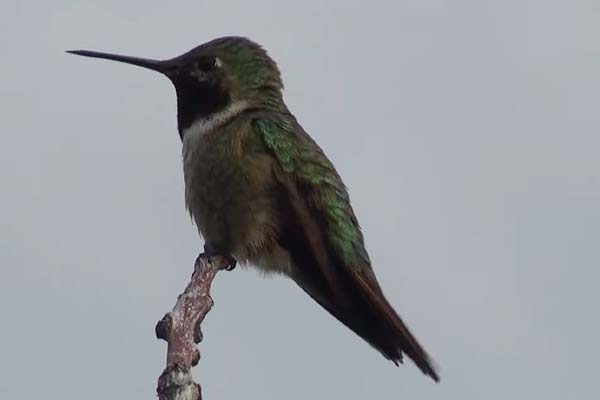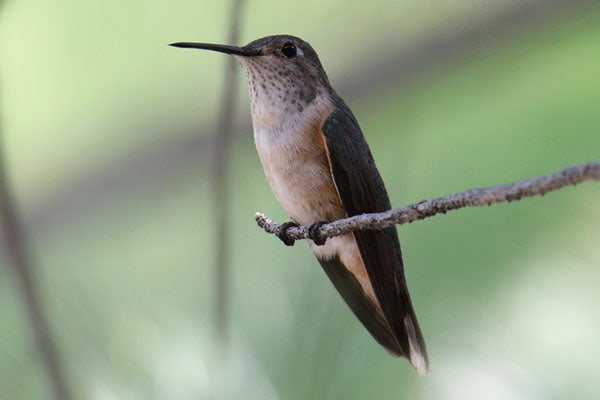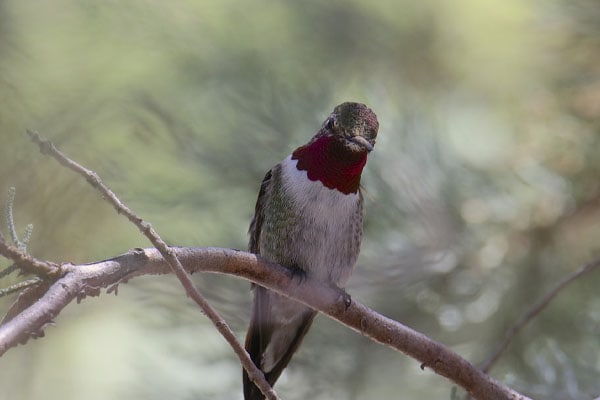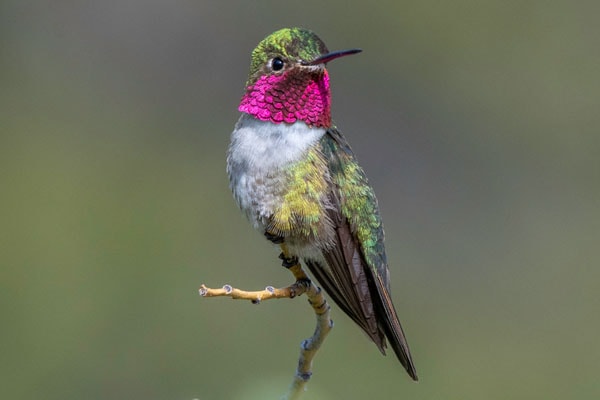Contents
Although its scientific name is Selasphorus platycercus, the Broad-tailed hummingbird is a fascinating creature nonetheless. Mostly, you’ll discover this bird in plentiful numbers in the western part of North America, including Mexico and the United States.
These birds are best known for their vibrant colors, unique behavior, and defining characteristics that make them really stand out. They are a staple that seems to captivate nature lovers and bird enthusiasts alike.
As far as defining characteristics are concerned, the broad-tailed hummingbird is most noticeable because of its iridescent plumage. But this isn’t its only distinguishing feature of this hummingbird by any means. This bird is also capable of beating its wings so rapidly that it can hover and move with amazing precision and agility. Besides that, it can fly backward, which is an exciting skill that only a few hummingbirds can actually accomplish.
Thankfully, the Broad-tailed hummingbird doesn’t seem to be threatened at all, which is certainly a good thing because this beautiful bird deserves to survive and thrive. Nevertheless, it’s always best for us to focus on preserving and protecting their habitats because it could be very easy to harm areas filled with flowering plants, nesting material, and food that these birds love.
Right now, I would like to share detailed research that I discovered regarding broad-tailed hummingbirds with you today. This information is important and valuable, and it will tell you all that you’ve ever wanted to know about this diminutive bird. The topics I intend to cover include the following:
- Physical traits and descriptions of the broad-tailed hummingbird
- The overall differences between the male and female broad-tailed hummingbirds
- Migration patterns, dietary preferences, nesting habits, and feeding choices of broad-tailed hummingbirds
- Even more important information about broad-tailed hummingbirds
Would you like to uncover the truth about these hummingbirds? Continue reading below to learn so much about these miniature lightning-fast birds.

Broad-tailed hummingbird facts
- Common Name: Broad-Tailed Hummingbird
- Scientific Name: Selasphorus platycercus
- Scientific Family: Trochilidae
- Life Span: 4-8 years
- Size: 3.5 to 4.0 inches
- Wingspan: 5.0 .0 to 6.0 inches
- Weight: 0.1 to 0.2 oz
- Conservation status: Least Concern
How to identify a Broad-tailed hummingbird
Identifying these birds does it have to become a major challenge whatsoever. There are definitely specific key behaviors and features that set them apart from other birds. The key differences include the following:
- Size and Shape – Broad-tailed hummingbirds are relatively small since they only measure 9-10 cm in length or 3.5 to 4 inches. Their bodies are compact and their shape is streamlined. They have a long, thin bill and short legs.
- Plumage – as far as mail broad-tailed hummingbirds are concerned, the feathers on their heads and back are bright green, but the gorget patch on their throat is a sparkly iridescent red. When viewed under certain lighting conditions, the gorget sometimes looks like it is shimmering or the color appears black. Male underparts are gray or white. Females, on the other hand, have very dull and muted colors with a pale throat and gray and green upper body parts.
- Wing and Tail – broad-tailed Hummingbird wings are rounded and relatively broad, which makes sense since it’s part of the bird’s name. While perching, males have a white band that they display on the uppermost part of their tail feathers. It’s typically visible during flight too. The outer tail feathers of female broad-tailed hummingbirds are covered with white tips.
- Vocalizations – the broad-tailed Hummingbird has a number of different vocalizations that it makes. Both sexes make buzzing sounds, insect-like chirping, and high-pitched vocalizations. Males also make a trilling or whistling sound while performing courtship displays.
Difference between male & female Broad-tailed hummingbirds

The major visual differences in broad-tailed hummingbirds have to do with their size and plumage. The size difference isn’t all that noticeable since the males are only slightly larger than females on average.
The feathers are definitely different and visibly noticeable. Females do not have a flashy gorget but instead have a pale throat patch and no bright colors. Female tales have white tips on the outside but do not have the beautiful white band at the males’ present. Female colors are much more subdued and a lot less vibrant than their male counterparts as well.
Differences in summer plumage vs winter plumage
There are definite differences between summer plumage and winter plumage for broad-tailed hummingbirds. In fact, during the summer, which happens to be their breeding season, male and female members of the species exhibit very vibrant and colorful plumage.
When the winter rolls around and breeding season is at an end, male and female broad-tailed hummingbirds seem to lose the luster within their plumage. Their coloration becomes a lot more subdued and a lot less colorful.
Where you’ll see Broad-tailed hummingbirds
Broad-tailed hummingbirds prefer to spend the bulk of their time in the Western regions of North America. In particular, they mostly stay in the United States and Mexico. To get more specific, the areas that they tend to occupy include:
- Rocky Mountains – these birds are typically found within the Rocky Mountains range that stands from Montana, Wyoming, New Mexico, Colorado, and Idaho, as well as parts of Utah and Arizona.
- Southwestern United States – you can find them in a number of different states in the southwestern portion of the United States including Texas, California, and Nevada.
- Mexican Plateau – these birds inhabit the highlands of central Mexico, in particular in areas including the Sierra Madre Occidental and the Sierra Madre Oriental.
- Mountainous Regions – broad-tailed hummingbirds love living at higher elevations, which is why they tend to inhabit mountainous regions. They prefer areas in the mountains with lots of meadows, aspen groves, and coniferous forests.
Broad-tailed hummingbird migration patterns
These birds are particularly impressive because they have the ability to fly long distances for migrations. They are also seasonal migrators, which means they’ll migrate back and forth between their wintering grounds and summer breeding grounds.
During their breeding season, which usually takes place from April-September, these birds are typically located within the northern portion of their breeding range. Usually, this is made up of the Western regions in North America. They also like to breed in mountainous areas, including the Rocky Mountains, because they prefer high elevations. They’ll also breed in areas of Mexico as well as the western United States.
After the breeding season is over and autumn is quickly approaching, these birds tend to migrate in a southward direction. Their wintering grounds are found in Mexico and Central America, which is a remarkable and very long journey.
During the winter, broad-tailed hummingbirds are usually found in the Mexican Plateau and other areas of Mexico, including the central highlands.
Diet & feeding preferences
As far as their diet is concerned, the broad-tailed Hummingbird has certain food sources that it definitely prefers. They include:
- Nectar – the bulk of their energy comes from consuming nectar since it makes up the primary source of all of their calories. Their long and slender bills and specialized tongues make it easy to extract nectar from all types of plants and flowers. Specifically, their favorite flowers to get nectar from include larkspurs, columbines, and penstemons.
- Insects – besides delicious nectar, these birds will also supplement their diet by eating certain insects and spiders. Particularly, they like small insects that fly, including mosquitoes, fruit flies, and gnats. Small arthropods are also on their menu as well.
- Other Food Sources – broad-tailed hummingbirds aren’t afraid of taking advantage of man-made Food options like nectar from hummingbirds. If they come across a hummingbird feeder in someone’s garden or backyard, they will enjoy the nectar solution. This is particularly true when nectar sources aren’t as readily available during certain seasons.

Broad-tailed hummingbird nesting
- Clutch Size: 1-3 eggs
- # of Broods: 1 brood
- Incubation Period: 14-17 days
- Nesting period: 20-23 days
- Egg Description: White or Off-White
These birds definitely have their own fascinating nesting habits. Like choosing a nest location. Typically, they will pick a location in higher elevations in areas of mountainous regions. They love living in areas that make great nesting habitats including meadows, aspen groves, and coniferous forests.
When it comes to constructing the nest, the female is 100% responsible for this job. She creates a small cup-shaped nest made of soft plant materials like lichen, moss, and plant fiber. She typically camouflages the outside of the nest with lichen or bark so that it better blends in with the other surroundings.
Placing the nest is also very strategic for broad-tailed hummingbirds. They’ll place their nest on horizontal tree branches or hide it within shrubs. The female securely attaches the nest to spider silk or another sticky substance to use it as a support structure. Typically, these hummingbirds place their nest anywhere from 5-20 feet above the ground.
From a characteristic standpoint, their nests are very well-insulated and compact. They have a cup-shaped design that protects the eggs and keeps them warm. They line the interior of the nest with feathers and soft plant material to create a comfortable and welcoming environment.
The average clutch size is usually two eggs, but it could be as few as one egg or as many as three eggs. Incubation takes 16-18 days, and the female will keep day eggs warm with her body heat until it is time for them to hatch.
After the eggs hatch, the female is the one to provide care and feed for her hatchlings. She will regurgitate nectar and small insects into their mouth to allow the young birds to grow and thrive. On average, nesting usually lasts for 3-4 weeks, after which the young birds will fledge and then leave the nest entirely.
Broad-Tailed Hummingbird Behavior
Some characteristics of their typical behavior include:
- Feeding – these birds have the ability to hover in mid-air, which they tend to do while sipping nectar from their favorite flowers with their long slender bill.
- Territory – their territorial behavior is quite aggressive, to say the least. The males will defend their territory by engaging in aerial displays combined with aggressive dives, loud buzzing sounds, and other noises to deter other hummingbirds and different species and keep them away from their territory.
- Courtship – males do their best to attract females by putting on elaborate courtship displays. This consists of steep dives from great heights, loud buzzing and trilling sounds, and rapid wing beats. They also like to showcase their shimmering gorget by flashing at the females during courtship.
- Sunbathing – believe it or not, broad-tailed hummingbirds love sunbathing. They typically tend to perch in open areas. While here, they will spread their wings and expose their entire body directly to the sunlight. It is believed that sunbathing is the best way for these birds to maintain feather health while regulating their body temperature.
Conservation Status
The conservation status of the broad-tailed hummingbird is currently considered of Least Concern. This means that the population of this species is not facing an immediate threat of decrease or extinction. The population is stable at this time.
Fun & Interesting Facts
- Broad-tailed hummingbirds have an interesting distinctive whistling sound made by their wings while flying. This sound is specifically created when air passes over the tips of their primary feathers. It creates a fluttering noise because they are rapidly beating their wings at the same time.
- Male broad-tailed hummingbirds love displaying their vibrant gorget, which is also known as an iridescent throat patch. It shines very brightly and has vibrant hues of green, purple, and pink mixed in. They will point their gorget toward females during courtship to create dazzling visual displays when it hits the sunlight.
- Their tales are much broader than other hummingbirds, which is why they were given the name. They are in a broad, fan shape. Male tales are longer than females and females have rounded tales as well.
- High elevation breeding is their particular forte. These birds are found breeding in the Rocky Mountains and their nests are often more than 10,000 feet off the ground.
- Their migration journey is one of the longest throughout North America. Many of these hummingbirds will travel as many as 2000 miles from one location to the next during seasonal migrations as they move from their breeding ground to their wintering ground and vice versa.
Explore More Species in This Family
- Black-crested Coquette (Lophornis helenae)
- Fiery-throated Hummingbird (Panterpe insignis)
- Long-tailed Hummingbird (Rhamphomicron longicauda)
- Black-breasted Puffleg (Eriocnemis nigrivestis)
- Violet-headed Hummingbird (Klais guimeti)
- Long-tailed Sylph (Aglaiocercus kingii)
- Magnificent Hummingbird (Eugenes fulgens)
- Snowcap (Microchera albocoronata)
- Violet Sabrewing (Campylopterus hemileucurus)
- Little Woodstar (Chaetocercus bombus)
- Purple-crowned Fairy (Heliothryx barroti)
- Gorgeted Woodstar (Chaetocercus heliodor)
- Booted Racket-tail (Ocreatus underwoodii)
- Violet-crowned Hummingbird (Amazilia violiceps)
- Plain-capped Starthroat (Heliomaster constantii)
- Sparkling Violetear (Colibri coruscans)
- Cinnamon Hummingbird (Amazilia rutila)
- Brazilian Ruby (Clytolaema rubricauda)
- Berylline Hummingbird (Amazilia beryllina)
- Costa’s Hummingbird (Calypte costae)
- Shining Sunbeam (Aglaeactis cupripennis)
- Long-billed Hermit (Phaethornis longirostris)
- Allen’s Hummingbird (Selasphorus sasin)
- White-necked Jacobin (Florisuga mellivora)
- Green-breasted Mango (Anthracothorax prevostii)
- Rufous Hummingbird (Selasphorus rufus)
- Buff-bellied Hummingbird (Amazilia yucatanensis)
- Ruby-throated Hummingbird (Archilochus colubris)
- Green Thorntail (Discosura conversii)
- Crowned Woodnymph (Thalurania colombica)
- Ecuadorian Hillstar (Oreotrochilus chimborazo)
- Xantus’s Hummingbird (Hylocharis xantusii)
- Blue-throated Hummingbird (Lampornis clemenciae)
- Calliope Hummingbird (Selasphorus calliope)
- Black-chinned Hummingbird (Archilochus alexandri)
- Black-throated Mango (Anthracothorax nigricollis)
- Bronze-tailed Plumeleteer (Chalybura urochrysia)
- White-vented Plumeleteer (Chalybura buffonii)
- Amethyst Woodstar (Calliphlox amethystina)
- White-bellied Woodstar (Chaetocercus mulsant)
- Anna’s Hummingbird (Calypte anna)
- White-tailed Goldenthroat (Polytmus guainumbi)
- Ruby-topaz Hummingbird (Chrysolampis mosquitus)
- Red-billed Streamertail (Trochilus polytmus)

